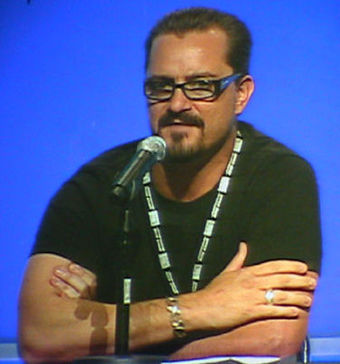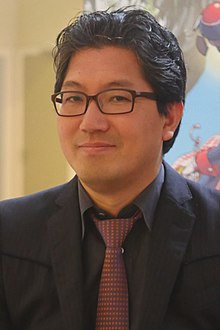Portal:Video games
The Video Games Portal

A video game, also known as a computer game or just a game, is an electronic game that involves interaction with a user interface or input device (such as a joystick, controller, keyboard, or motion sensing device) to generate visual feedback from a display device, most commonly shown in a video format on a television set, computer monitor, flat-panel display or touchscreen on handheld devices, or a virtual reality headset. Most modern video games are audiovisual, with audio complement delivered through speakers or headphones, and sometimes also with other types of sensory feedback (e.g., haptic technology that provides tactile sensations). Some video games also allow microphone and webcam inputs for in-game chatting and livestreaming.
Video games are typically categorized according to their hardware platform, which traditionally includes arcade video games, console games, and computer (PC) games; the latter also encompasses LAN games, online games, and browser games. More recently, the video game industry has expanded onto mobile gaming through mobile devices (such as smartphones and tablet computers), virtual and augmented reality systems, and remote cloud gaming. Video games are also classified into a wide range of genres based on their style of gameplay and target audience. (Full article...)
Featured articles –
Fez is a 2012 indie puzzle-platform game developed by Polytron Corporation and published by Trapdoor. The player-character Gomez receives a fez that reveals his two-dimensional (2D) world to be one of four sides of a three-dimensional (3D) world. The player rotates between these four 2D views to realign platforms and solve puzzles. The objective is to collect cubes and cube fragments to restore order to the universe.
The game was called an "underdog darling of the indie game scene" during its high-profile and protracted five-year development cycle. Fez designer and Polytron founder Phil Fish gained celebrity status for his outspoken public persona and his prominence in the 2012 documentary Indie Game: The Movie, which detailed Fez's final stages of development and Polytron's related legal issues. Fez met critical acclaim upon its April 2012 release for Xbox Live Arcade. The game was ported to other platforms following the expiration of a yearlong exclusivity agreement.
Reviewers commended the game's emphasis on discovery and freedom, but criticized its technical issues, in-game navigation, and endgame backtracking. They likened the game's rotation mechanic to the 2D–3D shifts of Echochrome, Nebulus, Super Paper Mario, and Crush. Fez won awards including the Seumas McNally Grand Prize and Eurogamer's 2012 Game of the Year. It had sold one million copies by the end of 2013, and it influenced games such as Monument Valley, Crossy Road, and Secrets of Rætikon. A planned sequel was canceled when Fish abruptly left game development. (Full article...)
Natsume developed Wrath of the Darkhul King as an action game; dialogue was limited in order to focus on gameplay, and puzzles were added for variety. The game received generally negative reviews from critics, who disliked the controls, combat system, and level design. The graphics and audio received a more mixed response. Retrospective reviews of Wrath of the Darkhul King have remained negative. For two weeks, the game was in the top ten most-ordered games on Amazon. (Full article...)
The game follows the five Simpsons family members—Homer, Marge, Bart, Lisa and Maggie—who learn they are part of a video game and are given superpowers to resolve several situations. Eventually, they must save their 8-bit predecessors from Will Wright, and the creator of their video game character selves, Matt Groening. The Simpsons family travels to four scenarios in parodies of other games to collect key cards used to infiltrate their creator's mansion and ultimately to save their predecessors from destruction to reverse their generations old ban on video games.
The game was met with mixed to positive reception from video game critics. They praised its visuals, writing, and faithfulness to the original material, while they criticized its short length and poor camera system, which did not always function properly. The Simpsons Game received the Best Game Based on a Movie or TV Show award at the 2007 Spike Video Game Awards and was nominated for Best Video Game Writing at the 2007 Writers Guild of America Awards. As of January 31, 2008, four million copies of the game have been sold worldwide. (Full article...)
The game was directed by Fumito Ueda and developed at Sony Computer Entertainment's International Production Studio 1, also known as Team Ico, the same development team responsible for the acclaimed PlayStation 2 title Ico, to which the game is considered a spiritual successor. Сonceived as an online multiplayer game titled NICO directly after Ico's completion, Shadow of the Colossus underwent a lengthy production cycle during which it was redeveloped as a single-player title. The team sought to create an outstanding interactive experience by including a distinct visual design, an unorthodox gameplay template, and non-player characters with sophisticated artificial intelligence such as the colossi and Wander's horse, Agro.
Cited as an influential title in the video game industry and one of the best video games ever made, Shadow of the Colossus is often regarded as an important example of video games as art due to its minimalist landscape designs, immersive gameplay, and emotional weight of the player character's journey. It received wide critical acclaim by the media and was met with strong sales compared to Ico, due in part to a larger marketing campaign. The game won several awards for its audio, design, and overall quality. A remastered version for the PlayStation 3 was released alongside Ico as The Ico & Shadow of the Colossus Collection in September 2011, developed by Bluepoint Games, who later produced a remake in high definition of the game for the PlayStation 4 in 2018. (Full article...)
Blizzard announced in March 2006 that the game was put on "indefinite hold" while the company investigated seventh generation video game console possibilities. Subsequent public statements from company personnel had been contradictory about whether production was to be renewed or planned story elements worked into other products. The continued delay of Ghost caused it to be labeled vaporware, and it was ranked fifth in Wired News' annual Vaporware Awards in 2005. In 2014, Blizzard president Mike Morhaime confirmed that Ghost had been canceled.
Unlike its real-time strategy predecessor StarCraft, Ghost was to be a third-person shooter, and intended to give players a closer and more personal view of the StarCraft universe. Following Nova, a Terran psychic espionage operative called a "ghost", the game would have been set four years after the conclusion of StarCraft: Brood War and cover a conspiracy about a secretive military project conducted by Nova's superiors in the imperial Terran Dominion. Very little of the game's storyline has been released; however, in November 2006 after the game's postponement, a novel was published called StarCraft Ghost: Nova, which covers the backstory of the central character. (Full article...)
Kingdom Hearts II is the third game in the Kingdom Hearts series, and takes place one year after the events of Kingdom Hearts: Chain of Memories. Sora, the protagonist of the first two games, returns to search for his lost friends while battling the sinister Organization XIII, a group of antagonists previously introduced in Chain of Memories. Like previous games, Kingdom Hearts II features a large cast of characters from Disney and Square Enix properties.
Concepts for Kingdom Hearts II began during the end of development of Kingdom Hearts Final Mix, with the game entering full development in 2003 and being announced at Tokyo Game Show 2003. Most of the first game's development team returned, including director Tetsuya Nomura, with the game being developed concurrently with Chain of Memories. In developing Kingdom Hearts II, the development team sought to address user feedback from the first game, give the player more freedom and options in combat and present a deeper and more mature plot. (Full article...)
Did you know... -
- ... that LittleBigPlanet, a video game that allows the player to create levels, coincided with the rise of user-generated content?
- ... that the 2005 video game Bokura no Kazoku was inspired in part by the birth of its creator's first child?
- ... that Kamibox's video game A Joke That's Worth $0.99 is permanently on special offer because Itch.io does not allow $0.99 as a regular price?
- ... that deceased YouTuber Technoblade beat the video game Minecraft in hardcore mode using a racing-wheel controller?
- ... that the video game Pyongyang Racer was developed in North Korea for Koryo Tours, which organises tours to the country?
- ... that Kainé from the video game series Nier was created in response to a female staff member's vague wish for a "male heroine"?
- ... that approximately 85 percent of Manhattan was recreated for the 2008 video game The Incredible Hulk?
- ... that Terra Invicta's development company is a group of former volunteer video game modders that decided to release their own game after the success of their mod?
- ... that the name of the video game mod series Bomba Patch was inspired by éclairs?
- ... that development on the video game Expeditions: Rome was not affected by lockdowns from the COVID-19 pandemic because the developer was already split between Copenhagen and Istanbul?
- ... that the 1987 video game Oriental Hero was panned as "so incredibly bad it's almost worth a look"?
- ... that Goodboy Galaxy was the first commercially released video game for the Game Boy Advance in more than 13 years?
Selected biography –
Selected image -

Recent video game-related events
- August 15, 2024 –
- American video game magazine Game Informer discontinues publication after 33 years. The magazine's website is also shut down. (BBC News)
- May 24, 2024 – Uvalde school shooting
- Families in Uvalde, Texas, U.S., file a lawsuit against Daniel Defense and Activision Blizzard for creating the DDM4 V7 gun and promoting the weapon through the game Call of Duty, respectively. They also sue Meta Platforms for owning Instagram, which was used by the gunman. (AP)
- April 16, 2024 – 2023–2024 video game industry layoffs
- American video game company Take-Two Interactive lays off 5% of its workforce. (Reuters)
Topics
Categories
Things you can do
In other Wikimedia projects
The following Wikimedia Foundation sister projects provide more on this subject:
-
Commons
Free media repository -
Wikibooks
Free textbooks and manuals -
Wikidata
Free knowledge base -
Wikinews
Free-content news -
Wikiquote
Collection of quotations -
Wikisource
Free-content library -
Wikiversity
Free learning tools -
Wiktionary
Dictionary and thesaurus














































